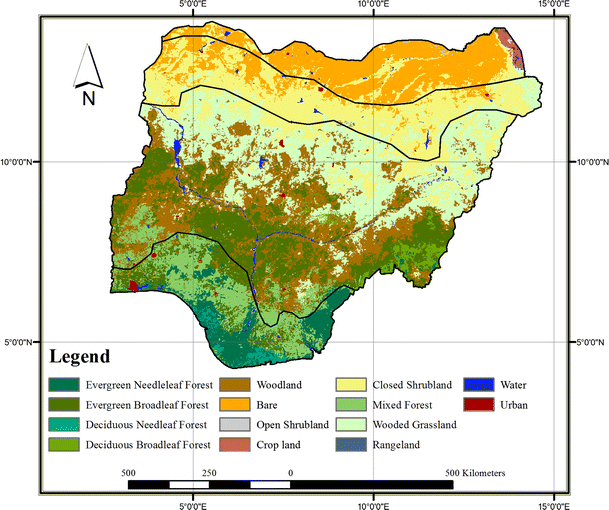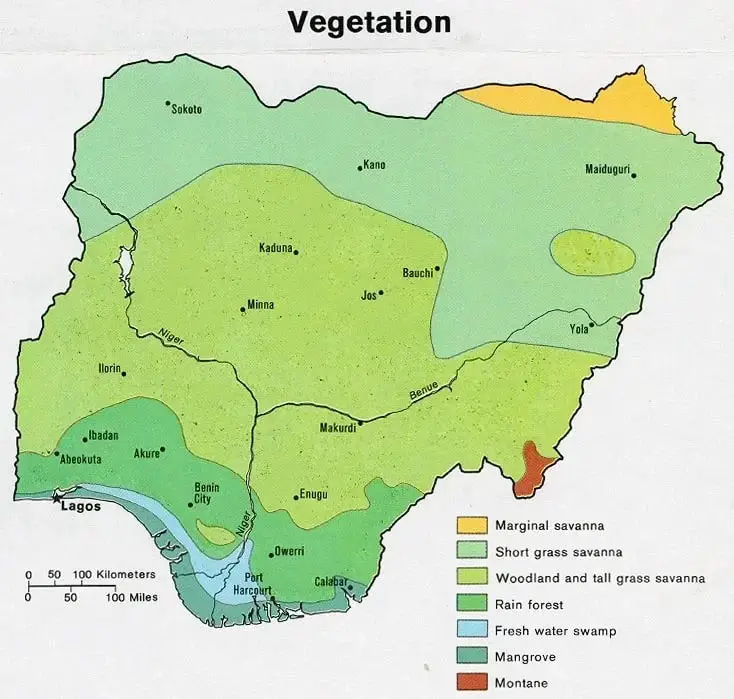Map of Nigeria Showing Vegetation Zones

As we discussed during our introductory course, Nigeria is a state that is a mixture of forests and Savannas. At one time, a large portion of the country was covered by thick tropical forests. Continuous cutting and burning of crop plots caused an enormous reduction in forest land, which now comprises around one-third of the land. Let’s take a look at the different zones of vegetation below:
Rainforest
The high-mountainous, multi-tiered tropical forest has been conserved mainly on the right bank of the lower reaches of the River Niger and the valley of the River Cross. Trees that are taller than 40-45 m make up the upper layer. The giants with strong trees with tree-shaped roots, which branch off from the bottom of the tree, aren’t in danger of the elements of nature.

The 2nd and third-level trees are heavily sprayed with epiphytes connected by lianas rushing toward the sun. The sun’s rays are almost impossible to penetrate the thick green canopy created by the crowns of woody trees.
In the northern part of the forest zone, where the annual rainfall is not more than 1600 millimeters, the circumstances for forest development are declining. The relative humidity is lower here, and soils are becoming drier. Certain plants shed leaves during the dry seasons. These are known as Dry tropical forests. They are also multi-tiered, but they are not as dense. The underbrush is challenging to get to. Yet, further north, the forest is becoming more sparse, and at last, the vast savannas are open.
Guinea Savanna
About half the land of Nigeria is covered by a moist savanna, also known as the Guinean high-grass Savanna. The average annual rainfall is between 1000-1400mm on the average. The parcels that comprise these savannas are in symbiosis with park savannas and connect the banks of the rivers by gallery forests. The grass can reach a significant high point, where it is not only artificial, but a vast animal may conceal. Within the savanna plants in Nigeria, wide varieties of elephant grass are predominant.
Several trees are atop the sea of grass, such as drought-resistant kaya, isoberlinia, and mitragina. A few have trunks that are twisted by annual fires. At the beginning of the dry seasons, the Savanna appears dead, and the trees appear dead. The smoke screen is raised over the Savanna in the middle part of the season. The dry grass is burned and is burned yearly to create fertile soil for the crops. The first rains are the time to see tender grass shoots and green leaves. Nigerian Savanna is awakened.
Sudan Savanna
In the north of the Guinea Savanna zone, rainfall decreases to between 500 and 1000 millimeters, and this dry period is longer than six-seven weeks. A Sudanese Savanna zone with a thick but thin grass cover is situated.
The distinctive look of the natural landscape is provided by various varieties of Acacia that have umbellate crowns and thorny bushes. Young shoots enthrall camels from the bushes, and leaves are commonly used in traditional medicine.
It’s hard to picture the Sudanese Savanna with no baobabs. In the vicinity, there are those palms resembling the whale, and the whitish Acacia, which sheds its leaves during the wet season and, in the dry season, is filled with fresh leaves, serving as sources of food and food for the animals.
In general, the natural conditions in the Sudanese Savanna are conducive to developing agriculture and livestock farming. Herds of cattle, sheep, and goats graze on vast grasslands. Due to the drought that the area experiences, there’s no tsetse fly in the area.
Sahel Savanna
The primary characteristic of the Sahel Savanna is its desert vegetation. The annual rainfall is low, and the wet season is between 3 and four months, so the vegetation in this region is scarce, and the current grasses are fragile. In this vegetation zone, species such as Ngibbi, Acacia radiant, Leptadenia, and African myrrh have flourished.
Montane
It is the Montane zone. It is located in the mountainous area. The montane vegetation in Nigeria (mountain and plateaus vegetation) isn’t very well developed because of low temperatures and the impacts of animals and humans. It is believed that the Jos plateau is among the highest places in Nigeria. This is a grassland zone. However, the slopes are surrounded by forests. This area is ideal for growing wide varieties of various vegetables and more minor grain crops and is simply a perfect spot to cultivate pastures.
Mangrove Zone
Mangrove vegetation is influenced by the location of the coastline of the zone and is subject to the constant impact of salty seawater. The soil of the Mangrove zone is impoverished. The Mangrove zone is inferior and has salt. The areas, which were stabilized and are not salt marsh, are ideal for rice cultivation.
Nigerian vegetation and Fauna
Fact
Fauna encompasses all animals that live in the life in a particular area or time. The term used for plants is the term flora. Flora, Fauna, and other life forms like fungi are collectively known as biota.
The plant life of Nigeria is varied, especially in the north and east in the areas where there is virtually none of the rain. This is the place known as the Sahel (deserted) spreads. There is almost none of the green plants that grow there. On the opposite side of Lake Chad, on the contrary, there are Reeds and papyrus flourish. In the Nigerian Savanna and forests, various species of animals eat.
In the past 200 years, there was a chance to observe these herds of rhinoceroses, elephants, giraffes, and numerous others. However, their number has drastically diminished. The largest herds are found exclusively in reserves and parks, particularly in the Bauchi plateau in the Yankari reserve.
In savannas, the most popular largest animal can be found in the leopard. Of the smaller – numerous are hyenas and Jackals. Antelope can weigh up to three dozen species. In the forest, the antelope dik-dik can be found with a weight of around 3 kilograms. Away from the more populated areas, we can see an anteater with scaly skin and substantial buffalo herds grazing.
Tropical forests are the ideal habitat for animals that climb. It includes monkeys, a variety of types of monkeys, baboons, and lemurs. Gorillas and chimpanzees have been able to survive. Hippos are also found at the Lake of Chad, a hippopotamus that dwarfs lives in the delta of Niger. The rivers are where a rare mammal can be seen, which is called the sea cow. On Nigerian waters, you may encounter crocodiles, particularly on the banks of Kaduna.
Nigeria has a wide diversity of birds, such as parrots, hoopoes, and red woodpeckers. There are also a lot of scoters, magnificent flamingos, kingfishers, and lazy pelicans. There are a variety of bird species of prey, particularly black African kites. There’s also a bird secretary or hawks. There is also the rhinoceros bird. Nigeria can be described as “rich” with many insects.
The critical role of vegetation
Nigerian forests’ most valuable vegetation species are the kaya and Iroko, sapel and Opepe, Agba, and Obeche. Each of them produces decorations and building timber. In the depressions of relief along the freshwater lagoons’ inner swamps and within the deltas of Niger (where the saltwater cannot enter), the look of the forest is distinct. The trees in these areas are smaller and aren’t as diverse.
The green leaves from the pandanus with a candelabra shape make a great material to weave mats and baskets. The leaves of raffia palms are roofing materials, and trunks are sent to rafters. Rafia produces piassava fiber that is used for the production of brushes and paint brushes. The juice from the grapevine is used to make wine.
Vegetation reflects environmental conditions, and it is essential to remain aware of radical changes. Nature natural resources and the natural vegetation of Nigeria are advantageous for business. Soil and the climate contribute to the development of peanuts, cocoa, and cocoa: cotton, oil palm, and numerous tropical crops. Nigerian streams and lakes are overflowing with fish. Nature has given Nigeria a wealth of fish.




